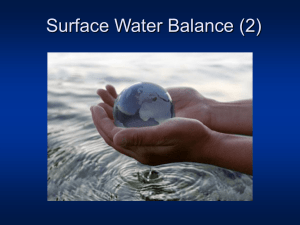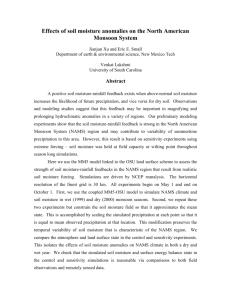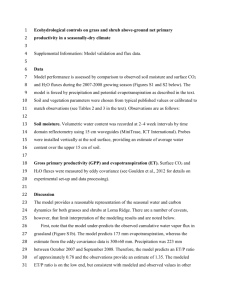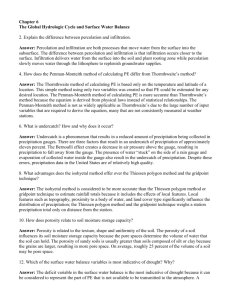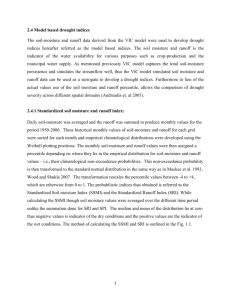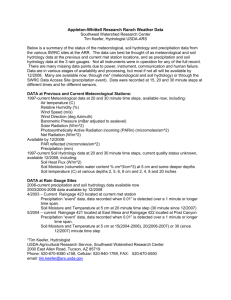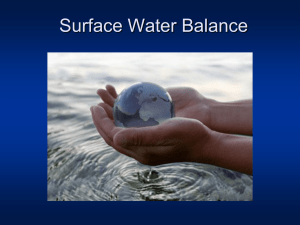chapter 6 the global hydrologic cycle and surface water balance
advertisement
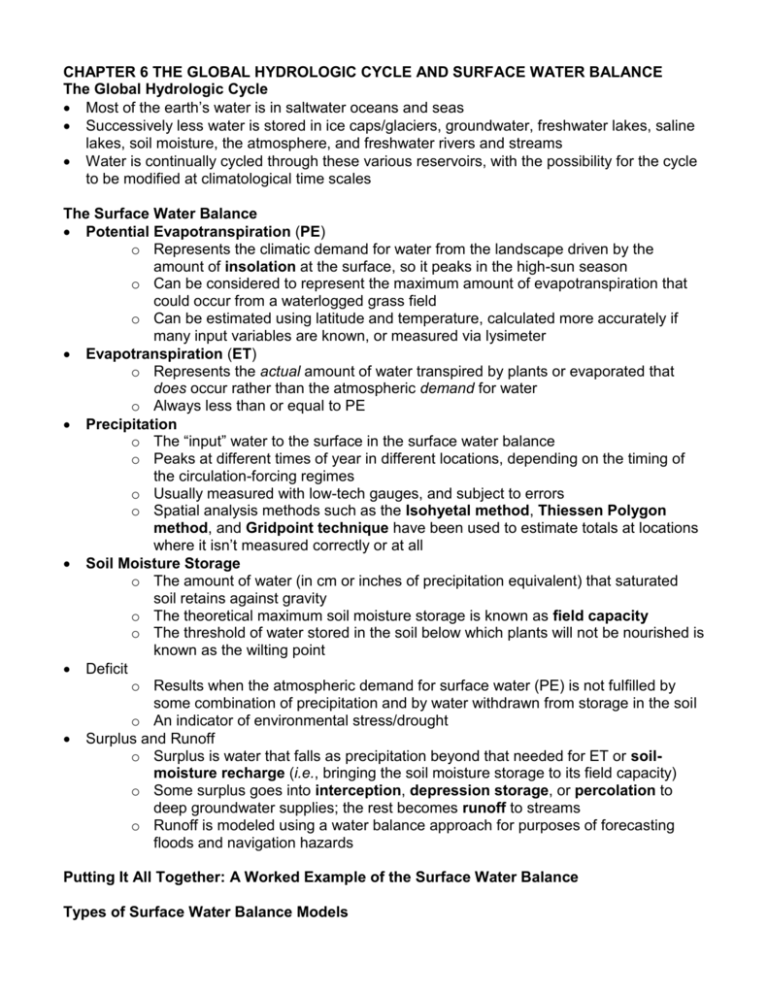
CHAPTER 6 THE GLOBAL HYDROLOGIC CYCLE AND SURFACE WATER BALANCE The Global Hydrologic Cycle Most of the earth’s water is in saltwater oceans and seas Successively less water is stored in ice caps/glaciers, groundwater, freshwater lakes, saline lakes, soil moisture, the atmosphere, and freshwater rivers and streams Water is continually cycled through these various reservoirs, with the possibility for the cycle to be modified at climatological time scales The Surface Water Balance Potential Evapotranspiration (PE) o Represents the climatic demand for water from the landscape driven by the amount of insolation at the surface, so it peaks in the high-sun season o Can be considered to represent the maximum amount of evapotranspiration that could occur from a waterlogged grass field o Can be estimated using latitude and temperature, calculated more accurately if many input variables are known, or measured via lysimeter Evapotranspiration (ET) o Represents the actual amount of water transpired by plants or evaporated that does occur rather than the atmospheric demand for water o Always less than or equal to PE Precipitation o The “input” water to the surface in the surface water balance o Peaks at different times of year in different locations, depending on the timing of the circulation-forcing regimes o Usually measured with low-tech gauges, and subject to errors o Spatial analysis methods such as the Isohyetal method, Thiessen Polygon method, and Gridpoint technique have been used to estimate totals at locations where it isn’t measured correctly or at all Soil Moisture Storage o The amount of water (in cm or inches of precipitation equivalent) that saturated soil retains against gravity o The theoretical maximum soil moisture storage is known as field capacity o The threshold of water stored in the soil below which plants will not be nourished is known as the wilting point Deficit o Results when the atmospheric demand for surface water (PE) is not fulfilled by some combination of precipitation and by water withdrawn from storage in the soil o An indicator of environmental stress/drought Surplus and Runoff o Surplus is water that falls as precipitation beyond that needed for ET or soilmoisture recharge (i.e., bringing the soil moisture storage to its field capacity) o Some surplus goes into interception, depression storage, or percolation to deep groundwater supplies; the rest becomes runoff to streams o Runoff is modeled using a water balance approach for purposes of forecasting floods and navigation hazards Putting It All Together: A Worked Example of the Surface Water Balance Types of Surface Water Balance Models Equal availability models assume that soil water is equally available to be evapotranspired regardless of the amount of storage in the soil Decreasing availability models assume that as soil-moisture withdrawal increases, the water becomes increasingly more difficult to be moved upward via ET The surface zone can be divided into two or more layers, such that water in the model is allowed to be lost more freely from the top layer but more stringently from successively lower layers Water Balance Diagrams Provide a graphical representation of the amount of water in precipitation, PE, ET, soilmoisture storage, soil-moisture recharge, deficit, and surplus over a given period of time Drought Indices The water balance approach can be used to derive various indices of moisture conditions on a near-real-time basis o The Palmer Drought Severity Index (PDSI) provides an assessment of long-term moisture conditions on a weekly basis by climate division across the United States o The Palmer Hydrological Drought Index (PHDI) is used for even longer-term analysis than the PDSI, and reflects conditions relating to groundwater availability and reservoir supplies o The Crop Moisture Index (CMI) is more useful for short-term agricultural interests because it is weighted heavily in the uppermost soil layers o The Keetch-Byram Drought Index (KBDI) was designed by the U.S. Forest Service to assess the risk of fire potential by examining the relationship between ET and precipitation in the organic matter on a forest floor and in the uppermost soil layers
